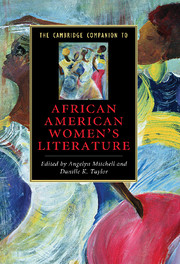Book contents
- Frontmatter
- Introduction
- Part 1 History, contexts, and criticism
- 1 Early African American women’s literature
- 2 Women of the Harlem Renaissance
- 3 Women writers of the Black Arts movement
- 4 Contemporary African American women writers
- 5 African American feminist theories and literary criticism
- Part II Genre, gender, and race
- Bibliography
- Index
5 - African American feminist theories and literary criticism
from Part 1 - History, contexts, and criticism
Published online by Cambridge University Press: 28 July 2009
- Frontmatter
- Introduction
- Part 1 History, contexts, and criticism
- 1 Early African American women’s literature
- 2 Women of the Harlem Renaissance
- 3 Women writers of the Black Arts movement
- 4 Contemporary African American women writers
- 5 African American feminist theories and literary criticism
- Part II Genre, gender, and race
- Bibliography
- Index
Summary
So when [Nel and Sula] met, first in those chocolate halls and next through the ropes of the swing, they felt the ease and comfort of old friends. Because each had discovered years before that they were neither white nor male, and that all freedom and triumph was forbidden to them, they had set about creating something else to be. Their meeting was fortunate, for it let them use each other to grow on.
- Toni Morrison, SulaLet's face it. I am a marked woman, but not everybody knows my name. “Peaches” and “Brown Sugar,” “Sapphire” and “Earth Mother,” “Aunty,” “Granny,” God's “Holy Fool,” a “Miss Ebony First,” or “Black Woman at the Podium”: I describe a locus of confounded identities, a meeting ground of investments and privations in the national treasury of rhetorical wealth. My country needs me, and if I were not here, I would have to be invented.
- Hortense Spillers, “Mama's Baby, Papa's Maybe: An American Grammar Book”In the penultimate paragraph of Harriet Jacobs's Incidents in the Life of a Slave Girl, Written by Herself (1861), Jacobs confides, “reader, my story ends with freedom; not in the usual way, with marriage.” Cherishing the freedom that she has secured for both herself and her children, Jacobs nevertheless laments the fact that “the dream of [her] life is not yet realized,” for she does “not sit with [her] children in a home of [her] own” (p. 664). Jacobs's narrative differs from both the autobiographical narratives of formerly enslaved African American men and the sentimental novels of Anglo- American and European women. Whereas Frederick Douglass's Narrative of the Life of Frederick Douglass, Written by Himself (1845) ends with him marrying and securing a home, Jane Austen's Pride and Prejudice (1813) culminates in an idealized bourgeois marriage in which happiness and prosperity are gained.
- Type
- Chapter
- Information
- Publisher: Cambridge University PressPrint publication year: 2009



